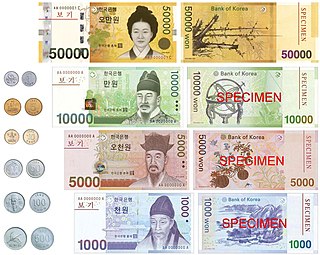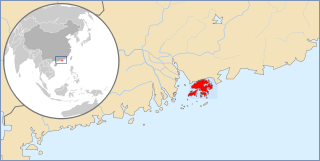
The renminbi is the official currency of the People's Republic of China. The renminbi is issued by the People's Bank of China, the monetary authority of China. It is the world's fifth most traded currency as of April 2022.

The Philippine peso, also referred to by its Filipino name piso, is the official currency of the Philippines. It is subdivided into 100 sentimo, also called centavos.

The tenge is the currency of Kazakhstan. It is divided into 100 tiyn.

The Korean People's won, more commonly known as the North Korean won and sometimes known as the Democratic People's Republic of Korea won, is the official currency of North Korea. It is subdivided into 100 chon. The currency is issued by the Central Bank of the Democratic People's Republic of Korea, based in the North Korean capital city of Pyongyang.

The South Korean won is the official currency of South Korea. A single won is divided into 100 jeon, the monetary subunit. The jeon is no longer used for everyday transactions, and it appears only in foreign exchange rates. The currency is issued by the Bank of Korea, based in the capital city of Seoul.
The New Taiwan dollar is the official currency of the Republic of China. The New Taiwan dollar has been the currency of the island of Taiwan since 1949, when it replaced the old Taiwan dollar, at a rate of 40,000 old dollars per one new dollar. The base unit of the New Taiwan dollar is called a yuan (圓), subdivided into ten chiao (角) or 100 fen (分), although in practice neither chiao nor fen are ever actually used.

The Singapore dollar is the official currency of the Republic of Singapore. It is divided into 100 cents. It is normally abbreviated with the dollar sign $, or S$ to distinguish it from other dollar-denominated currencies. The Monetary Authority of Singapore (MAS) issues the banknotes and coins of the Singapore dollar.

The ariary is the currency of Madagascar. It is notionally subdivided into 5 iraimbilanja and is one of only two non-decimal currencies currently circulating. The names ariary and iraimbilanja derive from the pre-colonial currency, with ariary being the name for a silver dollar. Iraimbilanja means literally "one iron weight" and was the name of an old coin worth 1⁄5 of an ariary. However, as of May 2023, the unit is effectively obsolete since the iraimbilanja has practically no purchasing power, and the coins have fallen into disuse.

The kip is the currency of Laos since 1955. Historically, one kip was divided into 100 att (ອັດ) which are no longer in regular use. The term derives from ກີບ kì:p, a Lao word meaning "ingot."

The Manchukuo yuan was the official unit of currency of the Empire of Manchuria, from June 1932 to August 1945.

The issue of banknotes of the Hong Kong dollar is governed in the Special Administrative Region of Hong Kong by the Hong Kong Monetary Authority (HKMA), the governmental currency board of Hong Kong. Under licence from the HKMA, three commercial banks issue their own banknotes for general circulation in the region. Notes are also issued by the HKMA itself.

The history of Chinese currency spans more than 3000 years. Currency of some type has been used in China since the Neolithic age which can be traced back to between 3000 and 4500 years ago. Cowry shells are believed to have been the earliest form of currency used in Central China, and were used during the Neolithic period.
The yuan is the base unit of a number of former and present-day currencies in Chinese.
The fourth series of the renminbi was introduced between 1987 and 1997 by the People's Bank of China. The theme of this series was that under the governance of the Chinese Communist Party, the various peoples of China would be united in building a Chinese-style social democracy.
The fifth series of the renminbi is the current coin and banknote series of the Chinese currency, the renminbi. They were progressively introduced since 1999 and consist of ¥0.1, ¥0.5, and ¥1 coins, and ¥1, ¥5, ¥10, ¥20, ¥50, ¥100 notes. The ¥20 banknote is a new denomination, and was added in this series. All banknotes in this series feature a portrait of Chinese Communist Party chairman Mao Zedong by artist Liu Wenxi. Therefore, this series of banknotes is also known as "Grandpa Mao" among the people.
The fifth series of the new Taiwan dollar banknotes is the current and latest series to be issued for circulation in the Republic of China (Taiwan). It was first introduced by the Central Bank of the Republic of China (Taiwan) on 3 July 2000.

Jiaochao is a Chinese word for banknote first used for the currency of the Jurchen-led Jin dynasty and later by the Mongol-led Yuan dynasty of China.
The history of Philippine money covers currency in use before the Hispanic era with gold Piloncitos and other commodities in circulation, as well as the adoption of the peso during the Hispanic era and afterwards.

The Great Ming Treasure Note or Da Ming Baochao was a series of banknotes issued during the Ming dynasty in China. They were first issued in 1375 under the Hongwu Emperor. Although initially the Great Ming Treasure Note paper money was successful, the fact that it was a fiat currency and that the government largely stopped accepting these notes caused the people to lose faith in them as a valid currency causing the price of silver relative to paper money to increase. The negative experiences with inflation that the Ming dynasty had witnessed signaled the Manchus to not repeat this mistake until the first Chinese banknotes after almost 400 years were issued again in response to the Taiping Rebellion under the Qing dynasty's Xianfeng Emperor during the mid-19th century.

The banknotes of the Da-Qing Bank were intended to become the main form of paper money of the Qing dynasty following the bank's establishment in 1905. The Da-Qing Bank had branches throughout China and many of its branches outside of its headquarters in Beijing also issued banknotes.









































































































































